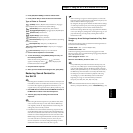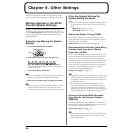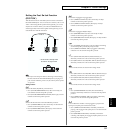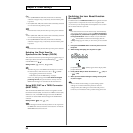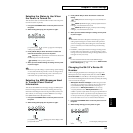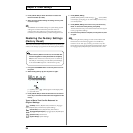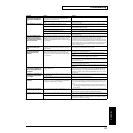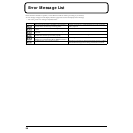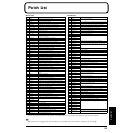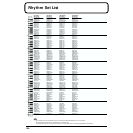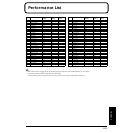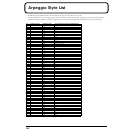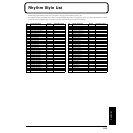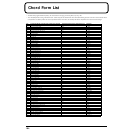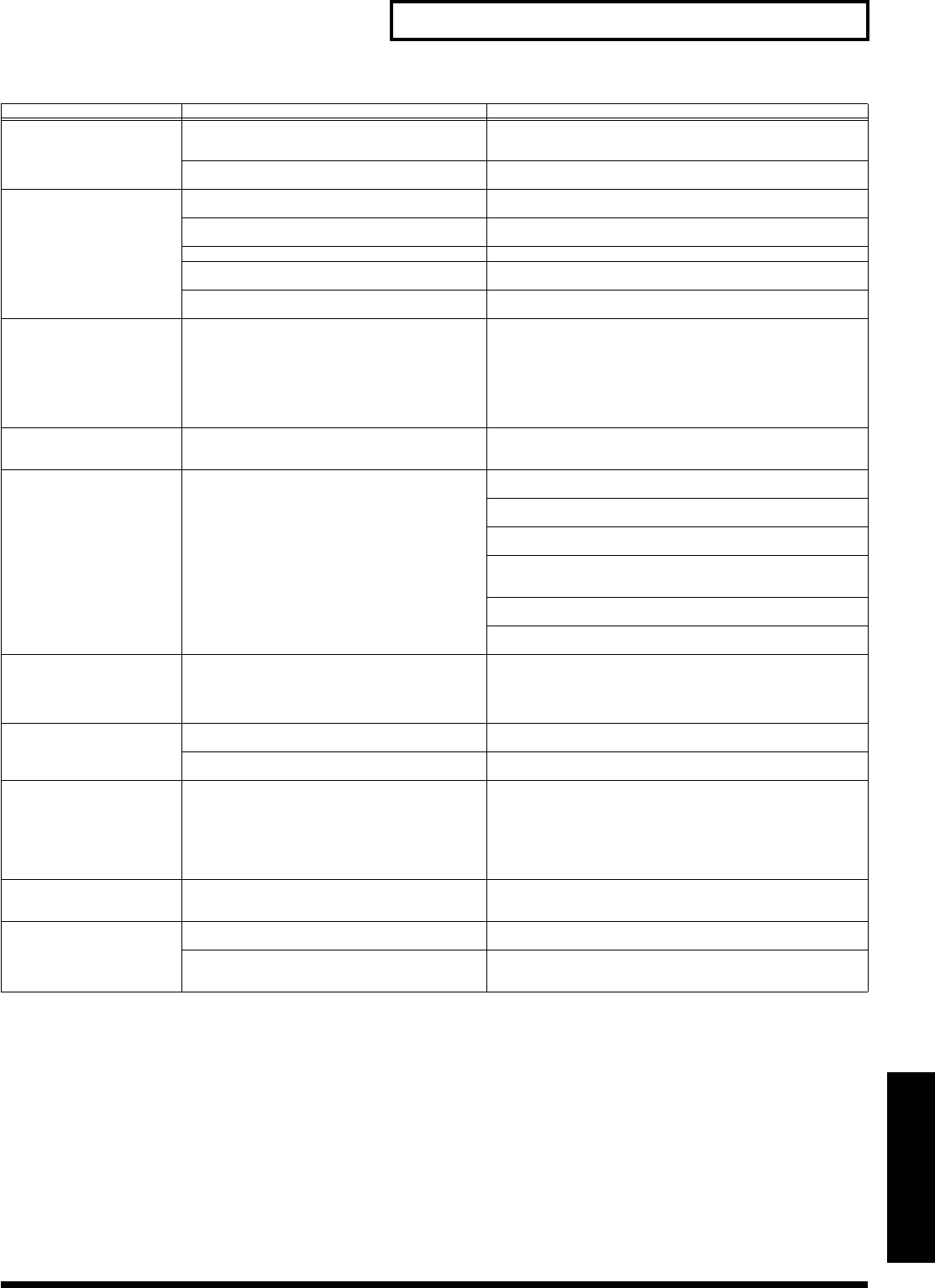
97
Troubleshooting
Appendices
Chords not sounding when
played/single notes played
even when Chord Memory is
on
Is SOLO, UNISON, OSC 1x2 SYNC (Oscillator Sync), or
some other function that would cause notes to be
played one at a time turned on?
Turn off such functions.
Does the Chord Form data have only one note recorded
to it?
Either record the Chord Form data over again or select a different
Chord Form (p. 81).
MIDI messages are not trans-
mitted / received correctly
Are the various MIDI channel settings correct? Check the Part MIDI channel, Performance Control channel and Re-
mote Keyboard Switch settings (p. 84, p. 90).
Are the various receive switch settings correct? Check the settings of the Program Change Receive Switch and the Ex-
clusive Receive Switch (p. 93).
Is the Bulk Dump setting (type) correct? Check the Bulk Dump setting (p. 88).
Is the Device ID Number setting correct? Set the Device ID Number that was used when recording the exclusive
data to the sequencer (p. 93).
Is the sequencer being played back at a correct tempo? Playback the sequencer at the tempo that was used when recording
the exclusive data.
When using MIDI Program
Changes, the switching of
sounds, and the production
of the sound after switching
takes too much time
Program Changes generally result in the modification
of large amounts of data at one time. If large volumes of
MIDI data are being transferred before and/or after
switching sounds, the SH-32 may be unable to make the
switch rapidly.
Try staggering the timing of such data transfers, for example by trans-
mitting data from the sequencer a little earlier, or otherwise prevent-
ing multiple, simultaneous switches. You can also try other
techniques, such as switching during breaks, or switching closer to the
end of a long note in a different Part (for studio work or other such de-
manding applications, we recommend the use of multiple sound gen-
erator modules or recording sequencer audio tracks sequentially,
mainly in Patch mode).
Poor MIDI transmission and
reception of panel opera-
tions
The conditions and behavior of MIDI transmission and
reception can be influenced by the MIDI transmission
mode settings.
Refer to the “MIDI Transmit/Receive Setting List” (p. 115) to check
the conditions of transmission and reception.
When using the SH-32 with a
sequencer, Patches are
played late after being
switched
In general, when a multifunctional sound generating
device and a MIDI sequencer are used together, pro-
cessing of the sounds being played may lag when
Patches are switched, or when large amounts of data
are transmitted.
Reduce the number of MIDI messages; for example, by using the se-
quencer to thin out the data stream.
Avoid having Program Changes occur simultaneously in multiple
Parts.
Use techniques such as switching sounds during breaks, whole notes,
or at other points where the beat is not conspicuous.
If at all possible, have any Patches that may be using two oscillators
use one oscillator instead. In addition, you may also want to use the
Suboscillator function.
Switch sounds with release times that are longer than necessary to
sounds with shorter release times.
Use an external MIDI splitter or thru box instead of the MIDI THRU
function.
The SH-32's Arpeggiator los-
es the tempo or stops when
the transmitting MIDI device
is adjusted
Are numerous MIDI messages being sent by the trans-
mitting MIDI device?
Certain operations, including the use of the Arpeggiator, result in a
large number of sounds being created. In such cases, the SH-32's sys-
tem gives priority to processing the sounds themselves, which may
halt the processing of large amount of MIDI data and prevent proper
functioning.
Bulk Dump or other data and
System Exclusive messages
not received
Do you have the Remote Keyboard Switch on, and the
Local Switch off?
Set the Local Switch to ON when the Remote Keyboard Switch is on.
Are the transmitting and receiving devices set to differ-
ent Device ID numbers?
Match up the Device ID numbers (p. 93).
Performances not switching
smoothly
Do you have sounds switching continuously more than
is necessary, or are you transmitting unneeded MIDI
messages immediately after switching?
When buttons or Program Changes are used in switching Performanc-
es, internal processing of large amounts of data occurs all at once. This
may cause malfunctioning, so avoid using the SH-32 for such opera-
tions.
* Using Program Change messages to switch entire Performances is
not an appropriate technique for switching sounds within the song
being played.
Arpeggios not being played
by the Arpeggiator
Do you have the Arpeggiator DURATION set to “Ft1”
(Filter 1) or “Ft2” (Filter 2) in the Patch or Performance?
In this case, rather than playing normal arpeggios, the SH-32 switches
to a function that creates the kind of sound changes you would get us-
ing a step filter; so, the keys that are pressed affect the filter.
The filter effect from the Ar-
peggiator is weak
Is the Arpeggiator's DURATION set to either “Ft1” (Fil-
ter 1) or “Ft2” (Filter 2)?
When “Ft1” is selected, no effect is produced by pressing only one key.
Is the Filter setting suitable? After confirming that the TYPE (Filter type) is not set to “OFF,” and
that [RESONANCE] is set somewhat high, use [CUTOFF] to find the
point at which the effect is stronger.
Problem Cause Action



